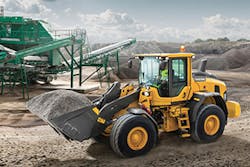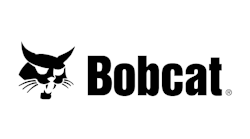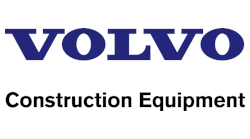“Our wheel loaders are all-around good utility machines for a heavy civil job site,” says Tommy Tynes, maintenance manager for Sundt Construction, a Tempe, AZ-based general contractor. “Our people use them with forks; we have quick couplers on the fronts so we can use a fork or a boom for setting pipe. We use them for backfilling pipe trenches, for picking and carrying concrete boxes, or pipe, or whatever needs carrying.
“We also use them for loading aggregate into trucks,” says Tynes. “We have a soil cement plant and two concrete plants. Typically we use our Caterpillar 966H for loading aggregate, but we can use a Cat 950 for the smaller plants.”
Sundt is an employee-owned company that works nationwide, but most jobs are west of the Mississippi River. Sundt buys all of its loaders new from the Arizona Caterpillar dealer, Empire Southwest. “We like to run newer equipment so that we can eliminate as much downtime as possible,” says Tynes. “We run them for about 10,000 hours and then we trade them in—sell them and purchase new ones. We buy them new because of the Caterpillar product—the support and service and price that we can get them at.”
Tynes says Sundt operators like the back-up cameras on the newer Cat loaders. The company owns 11 Caterpillar loaders, and seven are the 950-size machines. Tynes says the back-up cameras are a welcome feature on newer loaders because the exhaust emissions control equipment has required a higher hood in back, and that reduces visibility to the rear of the machine. “The 950 was a good machine for working around utilities and tight corners,” says Tynes. “Now with the higher hoods, they’ve gotten a little bit harder to see out of and they’re a little bit bigger. We’re still making them work, but a lot of times when you get into tighter areas we like to use a smaller machine like a 930-size model.”
Empire’s service and parts availability are impeccable, says Tynes. “We have a good dealer system that takes good care of us,” he says. “They’re very good at it—that’s one of the big selling points of Caterpillar. We can put a lot of hours on a machine, and if it goes down and is out of warranty, the Cat dealer jumps in and helps us with it. If necessary, the dealer talks to the factory and gets support from them.”
Earlier this year Caterpillar announced two new loaders at World of Asphalt—
the 966M XE and the 972M XE. Both have a Tier 4 Final-certified engine. The 966M runs a 298-horsepower Cat engine and can employ buckets from 3.25–12 cubic yards in size. The 972M runs a 311-horsepower Cat ACERT engine and carries buckets from 3.75 up to 13 cubic yards (lighter material).
Caterpillar says its ACERT engines meet Final Tier 4 standards with a combination of proven electronic, fuel, air, and aftertreatment components. The two loaders have been “designed to deliver superior performance and fuel efficiency while simplifying the operator’s interface and operating technique,” says a representative from Caterpillar.
K-Five Construction Co., a heavy/highway contractor based in south suburban Chicago, owns 17 wheel loaders, and 13 of them are Caterpillar machines. Two are John Deere loaders and two are Komatsu loaders. Seven of the loaders are used at K-Five’s asphalt plants, and the company has two concrete batch plants as well.
To make plant operations more efficient, K-Five recently brought its aggregate stockpiles closer together at the plants and improved their working surfaces. Because the loaders then did not have to travel as far to charge the plants, K-Five could use a smaller loader. As a result of those changes, the company figures it is saving 30–35% on loader fuel, compared to previous operations.
“We shrunk everything down so the loaders don’t have to travel as far,” says Dave Gorski, equipment manager at K-Five. “We downsized our loaders from nine-plus yards to eight-and-a-half-yard loaders. We went from Cat 988 loaders to Cat 980 size machines. The combination of things saved us about 30% on fuel.”
Volvo’s Newest
Just last April Volvo introduced its L60H, L70H, and L90H wheel loaders in the 165–184 horsepower range. The loaders have Volvo 6-liter Tier 4 Final engines that deliver high torque at low engine speeds.
Plus, the machines have what Volvo calls its Torque Parallel (TP) linkage. The TP linkage combines the benefits of Z-bar and parallel linkage to deliver high breakout torque and good parallel movement through the entire lifting height. Double seals on all linkage pins retain lubricating grease and prevent dust for durability and long machine life. A representative from Volvo says that the TP linkage geometry provides “excellent bucket roll-back angles for increased stability and less spillage.”
These new Volvo loaders are equipped with a counter shaft transmission. Various tailored settings enable the operator to match all applications, from short cycle truck loading to long distance load and carry operations. The machines are equipped with a 100% differential lock on the front axle, which provides better traction and rimpull on soft and slippery ground.
Volvo loaders are known for good fuel economy, and the L60H, L70H, and L90H machines have an eco pedal featuring a push-back mechanism that engages when engine speed is about to exceed the most economic operating range. The operator senses the resistance and reduces pressure to continue within this range. If full engine speed is needed, the push-back mechanism can be easily overridden.
The new series of Volvo loaders features load-sensing hydraulics that match power to the application. Load-sensing hydraulics make power available for rimpull, which makes for easier penetration into the pile. With help from variable displacement piston pumps and precision control levers, hydraulic power is delivered to match demand.
Compared to previous models, the Volvo L90H delivers more engine power, torque, and an improved hydraulic flow rate. The machine is also equipped with a longer wheel base for improved stability.
Volvo says the three loaders are built with operator comfort in mind. Noise and vibrations are minimized and visibility is maximized. Standard Automatic Heat Control and air conditioning make for a comfortable environment in the cab no matter what the ambient temperature is. And the air filtration system allows 90% of the cab air to be recirculated through the main filter for continuous dust removal and a cleaner cab environment.
New From Komatsu
Last fall, Komatsu America introduced the WA200-7 wheel loader. The new machine has a 126-horsepower, Tier 4 Interim certified Komatsu engine that is built on the company’s proven Tier 3 engine platform. Komatsu says fuel consumption on the WA200-7 has been reduced by up to 3% compared to the WA200-6 machine.
The new Komatsu loader replaces both the WA200-6 and the WA200PZ-6. Weighing between 25,342 pounds and 26,070 pounds, the new model features Komatsu’s Parallel Z-bar (PZ) loader linkage. This feature combines the advantages of a parallel lift linkage for pallet handling and high-tilt forces for large attachments. The PZ linkage also offers large breakout and lifting forces.
The WA200-7 has a Komatsu Tier 4 Interim engine that uses an advanced electronic control system to better manage air-flow rate, fuel injection, combustion and exhaust aftertreatment for better performance, reduced emissions, and improved fuel consumption. In the WA200-7 Komatsu also employs its electronically actuated variable flow turbocharger and exhaust gas recirculation valve. The company says the result is precise air management and long component life. The Komatsu Diesel Oxidation Catalyst (KDOC) is part of an integrated exhaust management system that does not interfere with daily operations. The KDOC is a 100% passive regeneration system that is good for the life of the engine and does not have a scheduled replacement interval.
Komatsu’s hydrostatic drivetrain is now in its second generation. The drivetrain features a large pump capacity for efficiency and responsiveness. The dynamic braking effect of the hydrostatic transmission slows the machine when the accelerator pedal is released. That effect, combined with wet disc brakes, minimizes brake wear. Additionally, the drivetrain features the Komatsu Traction Control System, which improves traction in soft or slippery ground. Simple traction controls feature MAX, Traction Control, and S-Mode. Variable Speed Control engages in first gear range and allows the operator to select a maximum speed between 3.2 and 8.9 miles per hour.
Komatsu says the WA200-7 provides convenient access to service points. The new wheel loader has increased cooling capacity, wider cooler fin spacing, and a standard auto-reversing fan to help keep the radiator clean. The machine is equipped with the Komatsu Equipment Management Monitoring System to provide enhanced diagnostic features. The monitoring system gives both operators and technicians the ability to more quickly troubleshoot the machine.
Deere’s K Series
John Deere offers its K Series of wheel loaders, which come with a wide variety of options in both Z-bar and parallel-lift configurations. The range of loaders runs from the 544K—a smaller utility loader—up to the big 377-horsepower 844K-II loader. Deere says the series features more spacious and quieter cabs with improved visibility, and easier-to-read multi-function monitors expand operator convenience.
The 544K has single-lever joystick or two-lever fingertip controls for low-effort control of the machine, according to Deere. Excavator-style hydraulics sense the load and deliver the needed hydraulic flow for fast work cycles. The PowerShift torque-converter transmission employs SmartShift technology to continuously evaluate speed and load conditions and adjust the clutch-pack engagement to match conditions.
On the 624K, John Deere offers a multi-function monitor with operation, diagnostic, and maintenance information on a color LCD screen. Ten percent more tinted glass and a lower-profile console allow a clear view of the work ahead. The quieter cab has more legroom and improved ergonomics.
The 644K loader has a 232-horsepower Tier 4 Final engine made by John Deere. Rated bucket capacity is 4.0–4.25 cubic yards. A representative from Deere says its Powerllel linkage delivers the best of the Z-bar and parallel lift linkages—”so you can have your loader and forklift too.” Excellent torque throughout the entire dump and roll-back range enables the 644K to do well at a variety of material handling jobs.
The 303-horsepower 744K-II from John Deere has larger new high-capacity axles with standard axle cooling and filtration for heavy-duty maneuverability. The loader has self-adjusting wet-disc brakes and advanced onboard diagnostics that offer push-button customization ofmachine operation and response.
The 844K-II, Deere’s largest loader, has a 377-horsepower Final Tier 4 engine with heavy-duty axles and a standard five-speed transmission. Rated bucket capacities range from 6.3–8.1 cubic yards. The 844K-II has many of the same features as its smaller brother, the 744K-II.
CASE Announces Tier 4 Final
CASE Construction Equipment recently announced that its 621F and 721F wheel loaders now meet Tier 4 Final emissions standards. Each model is equipped with a selective catalytic reduction (SCR) solution that treats emissions separately with diesel exhaust fluid and does not require the engine to recirculate exhaust gas. The company says the SCR solution is practical because it improves fuel efficiency by up to 20% compared to previous solutions, lowers exhaust temperatures, and provides excellent throttle response. There is no diesel particulate filter to require regeneration or maintenance.
The 621F and 721F loaders produce 162 and 179 net rated horsepower, respectively, both from a 6.7-liter engine. Both machines are available with a tool carrier or extended reach linkage and specialty configurations for other applications.
The 621F and 721F loaders have four programmable power modes that allow users to match the machine output to available engine power. The loaders include heavy-duty axles with auto-locking front and open rear differentials for optimal traction in most conditions. The two loaders also offer an optional “Efficiency Package” that includes a five-speed transmission with lock-up torque converter for even faster road travel speed, acceleration, and shorter cycle times. Axles have auto-locking differential and advanced system programming. The optional five-speed transmission includes the CASE POWERINCH feature that lets operators approach targets quickly and precisely regardless of engine speed.
Each wheel loader is covered by CASE ProCare, which is a suite of product assurances that include a three-year Advanced CASE SiteWatch telematics subscription, a three-year, 3,000-hour full machine factory warranty and a three-year, 3,000-hour planned maintenance contract. ProCare allows business owners to help make owning and operating costs predictable for the first three years of ownership.
Hyundai offers a range of six wheel loaders that start with the 2.5-cubic yard, 128-horsepower HL730-9A model. The company also offers a 156-horsepower, 3-cubic yard model, a 3.7-cubic yard model, and the 4.3-cubic yard, 222-horsepower HL760-9A. Two more models top out the range. Those are the HL770-9A, rated at 297 horsepower and 5.5 cubic yards and the HL780-9A, which has a 351-horsepower engine and is rated to carry 7.1 cubic yards.
JCB offers its compact Model 407 wheel loader, which is fitted with a 64-horsepower engine that produces 221 foot-pounds of torque and powers a two-speed hydrostatic transmission. The engine, made in conjunction with Kohler, is Tier 4-Final compliant. Low-rpm power and torque mean good fuel economy for the JCB 407.
JCB says the engine has a variable-speed crank-driven cooling fan that maintains optimum fan speed for all applications without using excess engine power. And the machine has a new high-speed roading option that allows it to travel at 25 miles per hour top speed. An innovative chassis permits power to transfer to the ground efficiently over all terrains. It offers several axle options on the Model 407, including open differentials for hard ground and limited slip differentials for soft muddy terrain.
The Model 407 features a 100% switchable front axle differential lock option to provide good traction in mud. Plus the front differential lock creates no shear forces, so it won’t damage the ground when not in use. It can also be engaged on the move and under load.
The JCB 427 has a 158-horsepower Cummins engine, ZF transmissions and axles, and Rexroth hydraulic pumps. The company uses state-of-the-art manufacturing processes such as robotic machining, precision painting technology, and innovative assembly techniques to help build quality into the machine. A heavy-duty center pin and oversized bushing on the JCB 427’s articulation joint provide good durability. And twin tapered roller bearings on the articulation joint can withstand both vertical and horizontal loadings.









